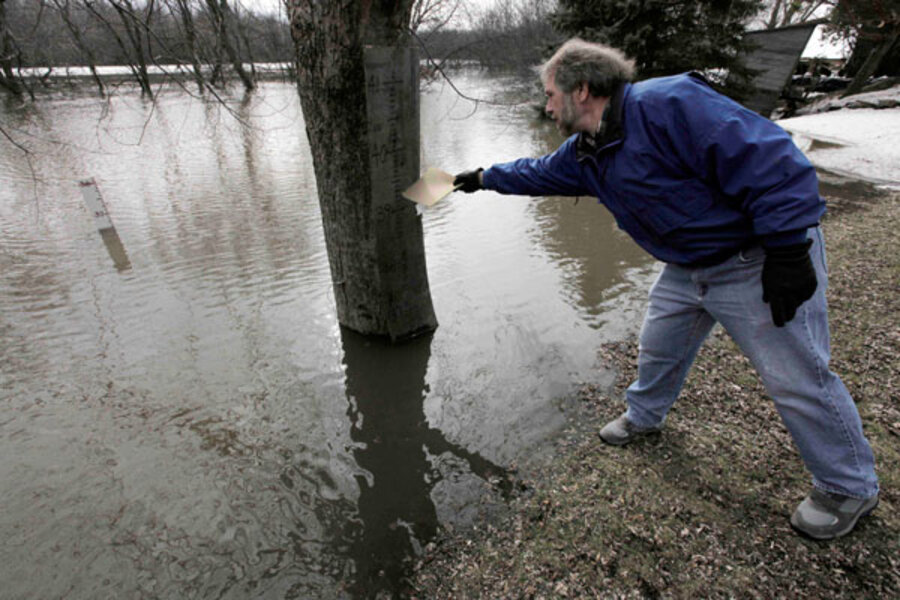Fargo flooding turns farms into lakes
Loading...
| Kragnes, Minn
For farmer Brian Thomas, getting to town for errands is no simple matter these days as floodwaters cover fields and sections of country roads in the rural areas near Fargo, N.D.
He wades through shallow rapids cascading across his driveway, then drives a mud-spattered pickup on a narrow dirt road until so much water blocks his path that he must hop into a motorboat and putt-putt over a cornfield resembling a sprawling lake. Finally, about four miles from home, he gets into his waiting car and drives to the nearest town.
"It's kind of a hassle," Thomas, 52, said Thursday as he jerked the rope to restart the boat motor.
As the cities of Moorhead, Minn., and next-door Fargo nervously wait for the Red River's expected crest on Sunday at 20 feet above the flood stage, some of the region's farmland is already under water after smaller rivers, swollen with melting snow, overflowed. Even fields that aren't buried in water are so saturated that they look like vast expanses of squishy black mud.
At this point it's mostly an inconvenience, growers say. Spring planting is a month or more away for crops such as corn, soybeans and sugar beets. If the rain holds off and unusually warm temperatures don't melt the remaining snowpack too rapidly over the next few weeks, the waters could recede, enabling a decent or even good growing season.
But a worst-case scenario — heavy spring rains and prolonged flooding well into April — could spell trouble for this year's crops, while also causing problems for livestock producers during the crucial calving season.
"It's definitely not going to help us any to have this flood, but I can't say definitely that it's going to hurt us either, because it depends on the weather from here on out," said Andrew Swenson, an extension farm management specialist at North Dakota State University.
The region's fertile soils yield an abundance of grain and beets. About 500,000 acres in Cass County — which includes Fargo — are planted in soybeans, more than in any other county in the nation.
Farmers prefer to get their corn and sugar beets in the ground by late April but can hold off until early May, when soybeans usually are planted, Swenson said.
Flooding in 2009 rendered almost 1.9 million acres unsuitable for planting in North Dakota, said Doug Hagel, regional director of the U.S. Department of Agriculture's Risk Management Agency in Billings, Mont. The floods then gave way to a cool summer and rainy fall, leaving the ground unusually moist even before this winter's snows began. In some places, up to 25 percent of last year's corn couldn't be harvested because of soaked fields.
"We may be looking at the same scenario this year and maybe magnified, because it was already so wet," said Doug Goehring, North Dakota's agriculture commissioner.
Thomas, a fourth-generation grower, has worked his acreage near the Buffalo River — a tributary of the Red River — for nearly three decades. He and neighbors weathered last year's deluge pretty well, though it delayed planting up to a month and reduced soybean and corn yields.
Back-to-back years of flooding is especially burdensome, he said. Not only could it throw off his planting schedule again, but he'll have to spend precious time clearing tree branches and other debris after the waters recede.
At least he's better prepared after last year's ordeal. He bought a couple of extra sump pumps to keep his basement dry as the river edges to within 100 feet of the ranch-style house where he and his wife, Darcy, live. He stockpiled fuel for their emergency power generators and removed the grain in his bins earlier, selling it or storing it on higher ground.
Flooding also poses hazards for livestock. About 90,000 head of cattle were lost in 2009 to drowning, disease or other weather-related causes, Goehring said. Lying on soaked ground damaged newborn calves' immune systems and caused hypothermia. In some places, rapidly rising waters left herds stranded in submerged fields and farmers unable to feed them or provide medical care.
Producers across the state are rushing herds to higher ground, clearing drains, building dikes and putting up temporary shelters, said Jack Reich, president of the North Dakota Stockmen's Association.
"Everybody's pretty nervous," said Reich, who lives in Mercer County, northwest of Bismarck. "The entire state was hit last year. I had some neighbors that were almost devastated. Nobody wants to get caught again."
Mark Huseth, who raises cattle about 50 miles southwest of Fargo, lost about 7 percent of his herd to blizzards and flooding.
"It was tough to keep them going when you couldn't find them in the snow," he said. "They'd get trampled. Then we had some drown. Some got pneumonia. It was not a good year."
Yet another headache: Overland flooding washes out country roads and drains, turning farms into islands. Some homesteads were reachable only by boat for up to six weeks last year — a situation Thomas knows well.
He says he wouldn't consider moving. Occasional floods are a blessing as well as a curse, boosting the productivity of the rich, loamy soil.
"All farmers are pretty optimistic," Thomas said. "I guess we'll hope for the best."





